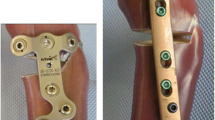Summary
Unreamed nailing with solid tibial nails is an accepted method of treatment for open tibial shaft fractures up to grade III and of closed tibial fractures with severe soft tissue damage. However, fatigue failure of the distal locking bolts is a frequent complication. We report a mechanical study investigating the fatigue limit of six different types of locking bolts used in solid tibial nails (Biorigid Tibial nail/aap, UTN/ace, STN/Howmedica, TLN/Howmedica, ΔR & T Tibial nail/Smith & Nephew, AO/ASIF UTN/Synthes). Our results prove a direct correlation between the bolt's diameter and mechanical properties. Further more we found that bolts with a continuing thread were weaker than bolts of the same diameter with only a short thread and an increased diameter at the nail's aperture. Our results suggest that mobilization with half of the average body weight (350N) allows osseous consolidation without fatigue failure of any of the tested locking bolts. Some of the tested locking bolts may even withstand full weight-bearing in a physiological walking cycle, but will not withstand the stress of a running cycle.
Zusammenfassung
Im Rahmen der Frakturbehandlung mit soliden Tibianägeln in unaufgebohrter Technik sind Ermüdungsbrüche der Verriegelungsbolzen wesentlich häufiger als ein Versagen des Verriegelungsnagels selbst. Infolge dieser Ermüdungsbrüche sind konsekutive Reoperationen oder zumindest eine verminderte Belastung der stabilisierten Extremität bis zur knöchernen Konsolidierung erforderlich. Anhand einer Materialprüfungsstudie wurden Verriegelungsbolzen 6 unterschiedlicher solider Tibianägel (biorigider Tibianagel/aap, UTN/ace, STN/Howmedica, TLN/Howmedica, ΔR & T-Tibianagel/Smith & Nephew, AO/ASIF UTN/Synthes) einer Biegeschwellbelastung unterzogen, die jener im Knochen-Implantat-Verbund zu erwartenden entspricht. Unsere Ergebnisse zeigten einerseits die direkte Korrelation des Bolzendurchmessers im Vergleich zur Ermüdungsfestigkeit des Implantates und andererseits das Faktum, daß Bolzen selben Durchmessers mit einem durchgehenden Gewinde eine signifikant niedrigere Lebensdauer aufweisen als Bolzen mit einem kopfnahen bzw. kopffernen Gewinde. Anhand unserer Ergebnisse konnten wir folgern, daß bis zum Erreichen der knöchernen Konsoliderung mit allen geprüften Implantaten, unter Verwendung der vorgesehenen Anzahl an Verriegelungsbolzen eine Mobilisierung mit halbem durchschnittlichen Körpergewicht von 35 kg möglich ist, ohne daß es zum Ermüdungsbruch der Verriegelungsbolzen kommt. Mit einigen der getesteten Implantate ist eine Mobilisierung mit vollem Körpergewicht möglich, allerdings ohne eine zusätzliche Belastung, wie es z. B. ein Laufmuster darstellt, zu erlauben.
Similar content being viewed by others
Author information
Authors and Affiliations
Rights and permissions
About this article
Cite this article
Gäbler, C., Tschegg, E., Greitbauer, M. et al. In-vitro evaluation of fatigue failure of locking screws in solid tibial nails. Unfallchirurg 102, 29–34 (1999). https://doi.org/10.1007/s001130050369
Published:
Issue Date:
DOI: https://doi.org/10.1007/s001130050369




